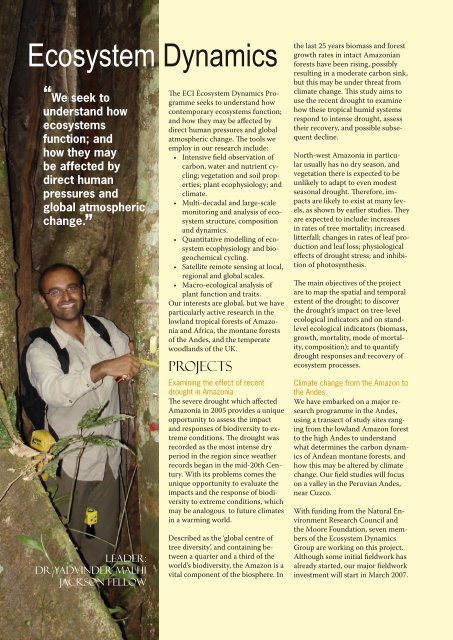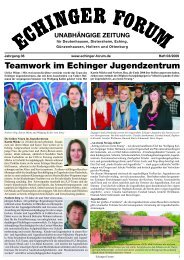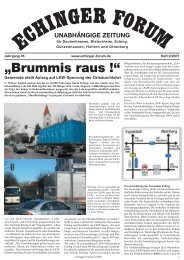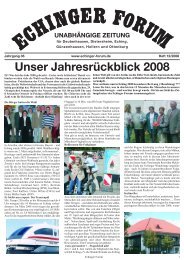Büro Karl Holmer Sachverständiger für Kraftfahrzeuge - Echinger Forum
Büro Karl Holmer Sachverständiger für Kraftfahrzeuge - Echinger Forum
Büro Karl Holmer Sachverständiger für Kraftfahrzeuge - Echinger Forum
You also want an ePaper? Increase the reach of your titles
YUMPU automatically turns print PDFs into web optimized ePapers that Google loves.
Ecosystem Dynamics<br />
1<br />
“We seek to<br />
understand how<br />
ecosystems<br />
function; and<br />
how they may<br />
be affected by<br />
direct human<br />
pressures and<br />
global atmospheric<br />
change.”<br />
Leader:<br />
Dr Yadvinder Malhi<br />
Jackson Fellow<br />
The ECI Ecosystem Dynamics Programme<br />
seeks to understand how<br />
contemporary ecosystems function;<br />
and how they may be affected by<br />
direct human pressures and global<br />
atmospheric change. The tools we<br />
employ in our research include:<br />
• Intensive field observation of<br />
carbon, water and nutrient cycling;<br />
vegetation and soil properties;<br />
plant ecophysiology; and<br />
climate.<br />
• Multi-decadal and large-scale<br />
monitoring and analysis of ecosystem<br />
structure, composition<br />
and dynamics.<br />
• Quantitative modelling of ecosystem<br />
ecophysiology and biogeochemical<br />
cycling.<br />
• Satellite remote sensing at local,<br />
regional and global scales.<br />
• Macro-ecological analysis of<br />
plant function and traits.<br />
Our interests are global, but we have<br />
particularly active research in the<br />
lowland tropical forests of Amazonia<br />
and Africa, the montane forests<br />
of the Andes, and the temperate<br />
woodlands of the UK.<br />
Projects<br />
Examining the effect of recent<br />
drought in Amazonia<br />
The severe drought which affected<br />
Amazonia in 2005 provides a unique<br />
opportunity to assess the impact<br />
and responses of biodiversity to extreme<br />
conditions. The drought was<br />
recorded as the most intense dry<br />
period in the region since weather<br />
records began in the mid-20th Century.<br />
With its problems comes the<br />
unique opportunity to evaluate the<br />
impacts and the response of biodiversity<br />
to extreme conditions, which<br />
may be analogous to future climates<br />
in a warming world.<br />
Described as the ‘global centre of<br />
tree diversity’, and containing between<br />
a quarter and a third of the<br />
world’s biodiversity, the Amazon is a<br />
vital component of the biosphere. In<br />
the last 25 years biomass and forest<br />
growth rates in intact Amazonian<br />
forests have been rising, possibly<br />
resulting in a moderate carbon sink,<br />
but this may be under threat from<br />
climate change. This study aims to<br />
use the recent drought to examine<br />
how these tropical humid systems<br />
respond to intense drought, assess<br />
their recovery, and possible subsequent<br />
decline.<br />
North-west Amazonia in particular<br />
usually has no dry season, and<br />
vegetation there is expected to be<br />
unlikely to adapt to even modest<br />
seasonal drought. Therefore, impacts<br />
are likely to exist at many levels,<br />
as shown by earlier studies. They<br />
are expected to include: increases<br />
in rates of tree mortality; increased<br />
litterfall; changes in rates of leaf production<br />
and leaf loss; physiological<br />
effects of drought stress; and inhibition<br />
of photosynthesis.<br />
The main objectives of the project<br />
are to map the spatial and temporal<br />
extent of the drought; to discover<br />
the drought’s impact on tree-level<br />
ecological indicators and on standlevel<br />
ecological indicators (biomass,<br />
growth, mortality, mode of mortality,<br />
composition); and to quantify<br />
drought responses and recovery of<br />
ecosystem processes.<br />
Climate change from the Amazon to<br />
the Andes<br />
We have embarked on a major research<br />
programme in the Andes,<br />
using a transect of study sites ranging<br />
from the lowland Amazon forest<br />
to the high Andes to understand<br />
what determines the carbon dynamics<br />
of Andean montane forests, and<br />
how this may be altered by climate<br />
change. Our field studies will focus<br />
on a valley in the Peruvian Andes,<br />
near Cuzco.<br />
With funding from the Natural Environment<br />
Research Council and<br />
the Moore Foundation, seven members<br />
of the Ecosystem Dynamics<br />
Group are working on this project.<br />
Although some initial fieldwork has<br />
already started, our major fieldwork<br />
investment will start in March 2007.

















